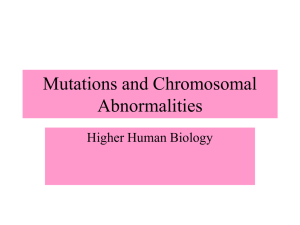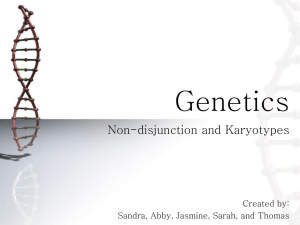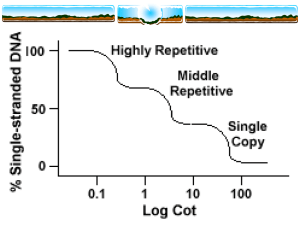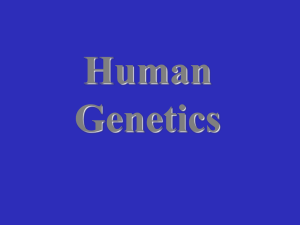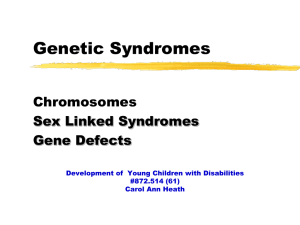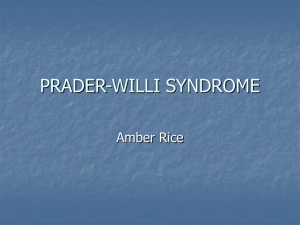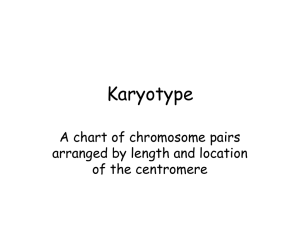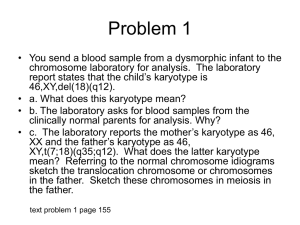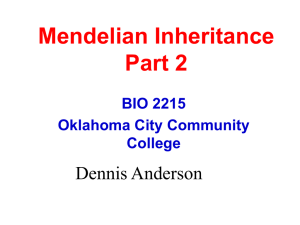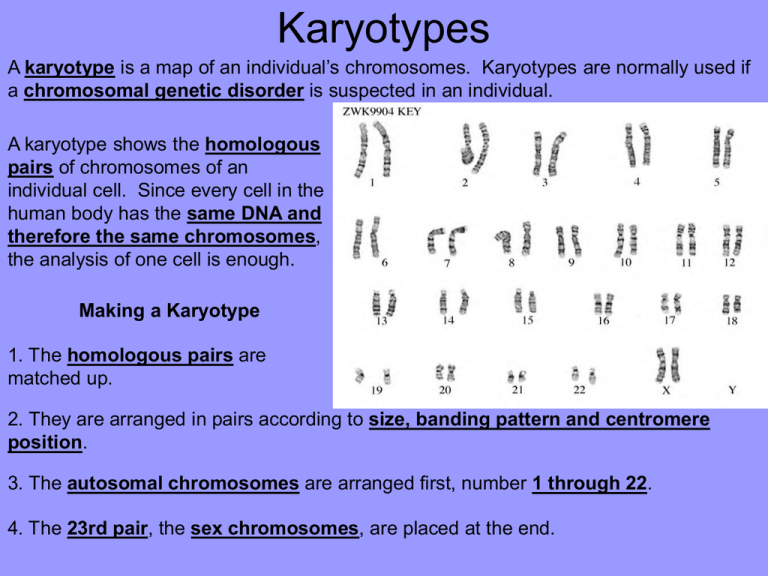
Karyotypes
A karyotype is a map of an individual’s chromosomes. Karyotypes are normally used if
a chromosomal genetic disorder is suspected in an individual.
A karyotype shows the homologous
pairs of chromosomes of an
individual cell. Since every cell in the
human body has the same DNA and
therefore the same chromosomes,
the analysis of one cell is enough.
Making a Karyotype
1. The homologous pairs are
matched up.
2. They are arranged in pairs according to size, banding pattern and centromere
position.
3. The autosomal chromosomes are arranged first, number 1 through 22.
4. The 23rd pair, the sex chromosomes, are placed at the end.
Labeling a Karyotype
1. First write down the number of chromosomes.
2. Next to the number write down the sex chromosomes.
3. If there are any chromosomal abnormalities list them last.
4. Write down the phenotype.
46 XY Normal Male
47 XXT21 Down syndrome
Chromosomal Abnormalities
Chromosomal abnormalities are caused by mistakes in meiosis or alterations of
chromosomes. There are several types of chromosomal abnormalities:
1. Trisomy-too many chromosomes caused by a non-disjunction during meiosis.
2. Monosomy-too few chromosomes caused by a non-disjunction during meiosis.
3. Alterations of chromosome structure (mutations):
A. Deletion: Removes a chromosome
segment.
B. Duplication: A repeat of a
chromosomes segment.
C. Inversion: A reverse of a segment
within a chromosome.
D. Translocation: Movement of a segment
from one chromosome to another, nonhomologous one.
Monosomy and Trisomy
Sometimes during the process of meiosis (making sex cells), chromosomes are not
correctly distributed into the two daughter cells. This is called a nondisjunction.
A nondisjunction can occur in anaphase I or II when the DNA is being pulled apart.
When this happens, one sex cell has both copies of a particular chromosome while
the other has none.
Monosomy: one that is missing a
chromosome. If fertilized the zygote
will have 45 not 46 chromosomes.
Trisomy: one that has an extra
chromosome. If fertilized the zygote
will have 47 not 46 chromosomes.
In general, humans can tolerate excess genetic material better than it can tolerate
missing genetic information. Either way there is normally severe side effects.
Disorders Caused by Nondisjunctions
Turner’s Syndrome: Not enough chromosomes (A Monosomy). Karyotype label, 45
XO. Often called monosomy X.
Frequency: 1 in every
5000 female births.
Symptoms (problems):
Individuals are missing
a second sex chromosome.
This is the only known
viable human monosomy.
The X chromosome is
necessary for life to occur.
The monosomy YO (male)
results in death of the fetus.
Individuals with Turner’s Syndrome are phenotypically female, however their sex
organs do not mature and secondary sexual characteristics fail to develop.
Individuals are sterile have a webbed neck, and short in stature. They are usually
mentally healthy but can be mentally challenged.
Approximately 98% of all fetuses with Turner syndrome spontaneously abort. Children
with Turner syndrome make up about 10% of the total number of spontaneous abortions
in the United States.
Highly expressed Turner’s syndrome
Klinefelter Syndrome
Klinefelter Syndrome: Too many chromosomes. Karyotype label, 47XXY.
Frequency: 1 in every 2000 male
births.
Symptoms (problems):
Individuals with Klinefelter
Syndrome have too many sex
chromosomes. It only takes one
Y chromosome to be male,
regardless of how many X
chromosomes he has. The extra
X chromosome has some
negative effects on the male
phenotype:
1. They are very tall.
2. They have male sex organs, but they are abnormally small.
3. They are usually sterile.
4. Some have feminine characteristics, like enlarged breasts and body curves.
Some individuals are XXXY, XXXXY or XXXXXY. The symptoms above are more
severe.
What does the extra X do?
Molecular explanation: The extra X
produces extra estrogen (a female
hormone) which changes the
phenotype of the male.
Trisomy X
Trisomy X: Extra X chromosome. Sometimes called Meta-females or super females).
Karyotype label, 47, XXX.
Frequency: 1 in every 1500
female births.
Symptoms (problems): They
have limited fertility and may
be mentally retarded.
How does this get passed down?
If an individual with Trisomy X is fertile and decides to have a child, what are the
possible genotypes and phenotypes her and a normal male can have?
Answers
Meta-female
Normal female
X
Y
XX
XXX
XXY
X
XX
XY
Klinefelter
syndrome
Normal male
Jacob’s syndrome
Jacob’s syndrome: An extra Y chromosome. Karyotype label, 47, XYY.
Frequency: 1 in every 1000
male births.
Symptoms (problems): The
extra Y chromosome may have
some affects on the male
phenotype:
1. They tend to be somewhat taller than the average male.
2. They tend to have slightly lower mental ability.
3. They tend to have excess acne on their body.
4. Studies of the prison system show that 85% of
inmates in prison for violent crimes have this
syndrome.
What does the extra Y do?
Molecular explanation: The extra Y chromosome produces extra testosterone (a male
hormone). This extra testosterone may cause excess aggression and acne.
The other side of the argument.
Down syndrome
Down Syndrome: An extra 21st chromosome.
Sometimes called trisomy 21. Karyotype label,
47XYT21 or 47XXT21.
Frequency: 1 in every 700
births.
Symptoms (problems): Down
syndrome is the most common
serious birth defect in the United
States. Having an extra 21st
chromosome severely alters the
individual’s phenotype:
Phenotypic expressivity varies in Down
Syndrome
1. They have characteristic facial features. A wide round face and many have trouble
with their eye sight.
2. Individuals have a short stature, stubby fingers and toes, heart defects,
susceptibility to respiratory infections and mental retardation. Vision problems and
large tongues.
3. Prone to develop leukemia and Alzheimer’s disease.
4. There life span is below average to average, in some cases living to middle age or
above.
Age and incidence of Down syndrome
Among normal parents, the incidence of Down Syndrome in offspring correlates with the
age of the mother.
A mother age
20 has a 1 in 1925
30 has a 1 in 885
40 has a 1 in 110
50 has a 1 in 12
Edward’s Syndrome
Edward’s Syndrome: An extra 18th chromosome. Sometimes called trisomy 18.
Karyotype label, 47XYT18 or 47XXT18.
Frequency: 1 in every 10,000
births.
Symptoms (problems):
1. Edward’s Syndrome affects
all the organs of the body. It
produces severe mental
retardation.
2. Feeding and breathing
difficulties
3. Specific body deformities: Underdeveloped or absent thumbs, underdeveloped
nails, webbing of the second and third toes, small pelvis with limited movements of the
hips and short breastbone
4. Specific facial deformities: Small head, low-set
malformed ears, abnormally small jaw, small mouth,
cleft lip/palate, widely-spaced eyes and upturned nose.
Most infants survive less than a year.
Patau Syndrome
Patau Syndrome: An extra 13th chromosome. Sometimes called trisomy 13.
Karyotype label, 47XYT13 or 47XXT13.
Frequency: 1 in every 5,000 births.
Symptoms (problems):
1. Patau syndrome is
characterized by serious eye,
brain, and circulatory defects, as
well as harelip and cleft palate.
2. Polydactyly, particularly of all
extremities, strongly suggests trisomy
13. Extra toes are seen here on each
foot.
3. baby with trisomy 13 has cyclopia
(single eye) with a proboscis (the
projecting tissue just above the eye).
4. Most infants survive less than a year.



